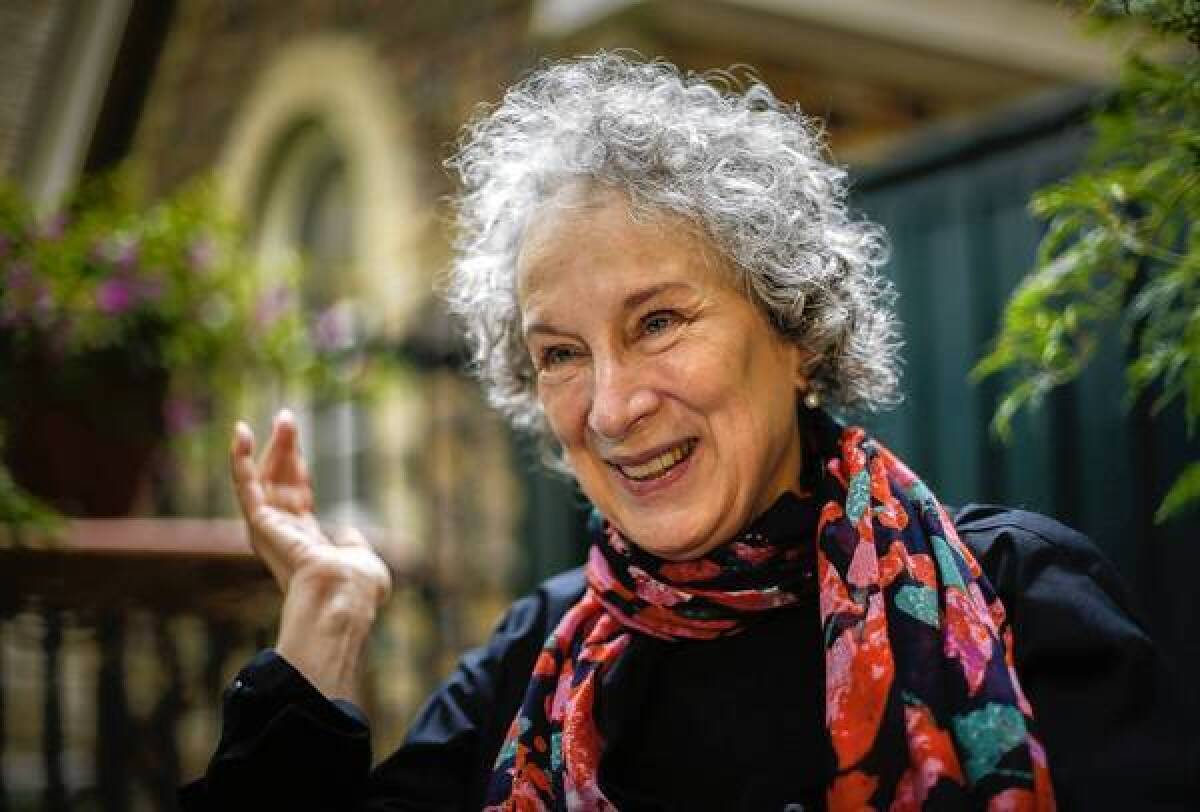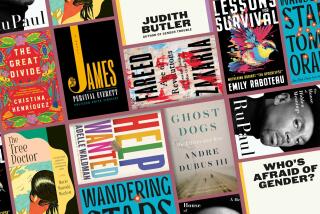Behold our mutant future in Margaret Atwood’s ‘MaddAddam’

- Share via
Sometimes Margaret Atwood can get a little goofy. I mean no disrespect to the author of “The Handmaid’s Tale” — in fact, it’s a good thing that she writes intelligent works of dystopian fiction with a sense of humor. Otherwise, the end of the world as we know it might be just too grim.
Her new novel, “MaddAddam,” concludes the trilogy begun in 2003 with “Oryx and Crake” and continued in “The Year of the Flood” (2009). The titles of the second and third books reference the origin and Noah stories found in the Bible. Atwood’s flood is a plague created by a brilliant geneticist playing God, a man called Crake who tries to wipe out all the humans on Earth while creating a better species. Members of a fringe environmental group that survived address their senior men as Adam and women as Eve. These biblical echoes are far from holy, however: a key locale is a high-end sex club calls “Scales and Tails,” where the acts incorporate snakes. Temptation, indeed.
In Atwood’s near-ish future, global warming has reshaped the landscape — Harvard has drowned, New York City has relocated to New Jersey, and L.A.’s Venice canals have filled with a dirty sea. The rich are ensconced in walled enclaves of plenty while everyone else is left to “pleeblands,” degraded former cities and suburbs rampant with lawlessness. Animals are going extinct at a quick clip while strange, sick hybrids are being genetically engineered to amuse and feed humans; military forces and the state have essentially become one.
Then things get even worse: A plague hits and kills nearly everyone, leaving a ruined, pillaged world. When “MaddAddam” begins, the survivors — a few geneticists and environmentalists — have assembled and are ready to start anew. They’re accompanied by the Crakers, the genetically engineered humanoid naifs who were designed to inherit the earth but may be too innocent to survive.
They face an array of obstacles: an overbright sun, dwindling man-made resources, huge threatening pigs called pigoons, and a pair of destructive humans, champions of a late-civilization game called Painball that always ended in death.
“MaddAddam” will be decipherable to those who haven’t read the other books, yet those who have won’t be bored; flashbacks fill in the story from new perspectives, particularly Zeb’s. A middle-aged bad boy, Zeb is the abused, black-sheep son of the corrupt Reverend of the Church of PetrOleum, who preached, “My friends, as we all know, ‘oleum’ is the Latin word for oil. And indeed, oil is holy throughout the Bible! What else is used for the anointing of priests and prophets and kings? Oil!”
Zeb taught himself computer hacking, siphoned money from his father’s embezzled accounts, and made a getaway with his brother Adam, a key figure in the events that follow. Zeb hides out in the marginal pleeblands, showing us the fringes of the society shortly before its collapse. His travels and adventures tie the threads of the trilogy together.
With puns and wordplay, Atwood pokes fun at our reality through the bleak future she’s imagined. She prefers the term “speculative fiction” to “science fiction” because, since “The Handmaid’s Tale,” she has seen her novels as extrapolations of the present into a possible future. One of her seemingly fanciful details, luminescent rabbits, has actually become a reality. The sexual enhancement drug that served as a carrier for the plague — called BlyssPluss — is not far removed from contemporary drugs like Viagra and Cialis.
Despite being almost completely depleted of its natural resources, the exhausted Earth seems to be on track for a kind of recovery in “MaddAddam.” The new climate brings thunderstorms every day and lots of kudzu, and the few animals that escaped extinction are coexisting with their genetically modified brothers. The new world includes those glow-in-the-dark rabbits, friendly, scentless rakunks (half-skunk, half-raccoon), liobams, wolvogs and pigoons.
Bred to grow replacement human organs — less morally controversial than clones, was the argument — the pigoons are large, tusked and seeded with human tissue that includes active brain matter, making them extraordinarily intelligent. Their only predators are the remaining humans; while half are former members of the God’s Gardeners eco-cult, they’re overly fond of bacon.
How the gene splicers and the outsider environmentalists are connected is slowly revealed in unfolding stories that, while overlapping, take distinctly different forms. Toby, who narrates much of “MaddAddam” as she did “The Year of the Flood,” hears much of Zeb’s story firsthand as the two lie together in bed. Their conversation is peppered with flirtatious intimacies. Yet when she tells those stories to the innocent Crakers, she wipes them clean of their darker elements, framing them as myth.
“There’s the story, then there’s the real story, then there’s the story of how the story came to be told. Then there’s what you leave out of the story. Which is part of the story too,” Toby thinks, elegantly encapsulating the shape of the novel.
After thousands of pages of complex world-building, readers may be expecting a whiz-bang finale, something Atwood does not build into “MaddAddam.” In fact, her storytelling choices and strategies leave “MaddAddam” feeling less urgent than the earlier novels. Characters that were once resourceful and desperate to survive now mill and mope. When serious conflict finally arrives, it is hidden within layers of storytelling, conveyed as a veiled, soft-focus legend.
Yet the imaginative universe Atwood has created in these books is huge, encompassing hidden Internet chat rooms, beekeeping, the survivors’ outfits (mundane patterned bedsheets) and penises that glow blue to signal sexual readiness. It’s a dystopia, but it’s still fun. “People were paying through the ceiling for those gene splices,” a scientist explains. “They were customizing their kids, ordering up the DNA like pizza toppings.”
Atwood doesn’t just ask what if, she raises an eyebrow and says, See where we’re going? Yet she’s not a pessimist: She’s invented a future large enough to include, after the end of the world, people falling in love.
MaddAddam
A Novel
Margaret Atwood
Nan Talese/Doubleday: 416 pp, $27.95
More to Read
Sign up for our Book Club newsletter
Get the latest news, events and more from the Los Angeles Times Book Club, and help us get L.A. reading and talking.
You may occasionally receive promotional content from the Los Angeles Times.











